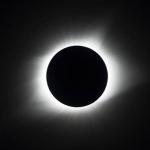1 And there appeared a great wonder in heaven; a woman clothed with the sun, and the moon under her feet, and upon her head a crown of twelve stars: 2 And she being with child cried, travailing in birth, and pained to be delivered.
3 And there appeared another wonder in heaven; and behold a great red dragon, having seven heads and ten horns, and seven crowns upon his heads. 4 And his tail drew the third part of the stars of heaven, and did cast them to the earth: and the dragon stood before the woman which was ready to be delivered, for to devour her child as soon as it was born.
5 And she brought forth a man child, who was to rule all nations with a rod of iron: and her child was caught up unto God, and to his throne. 6 And the woman fled into the wilderness, where she hath a place prepared of God, that they should feed her there a thousand two hundred and threescore days. Revelation 12:1-6
This is the less well-known version of the story of the birth of Jesus Christ in the New Testament. One of the reasons that it is less spoken about is because it is wrapped in mythological language. The story begins with the familiar elements of a pregnant woman, whose child is threatened after it is born. The child is prophesied to rule over all the nations, both Jew and Gentile. He is finally taken up to God and the woman is cared for.
Though there are valid alternative interpretations, the characters are more or less transparent as an account of Jesus’ birth. Mary is the woman and Jesus is the child. The dragon, which elsewhere figures as the Roman Empire, threatens Jesus using its vassals, either through Herod the Great in his infancy or through the high priesthood at the end of his life.
The text describes Mary as clothed with the sun, standing on the moon, with a zodiacal crown of stars. We know from ancient material evidence that this was very similar to the costume of the Hellenized Egyptian goddess Isis. (Isis wears the crowned moon on her head, instead of her feet.) Isis too is miraculously impregnated by a God (long story) and gives birth to the living King, Horus. She also must flee the dragon Typhon who persecutes her and her child.
In the iconography, Horus is depicted as a small child sitting in her lap, sometimes nursing. The image should be familiar to those who have seen the images of Mary and Child in Christian art. In the surviving documents about Isis, she is described as the foundation to the creation and ruler of the universe. Such a comparison between Mary and Isis is not without significance.

In recent decades, some have debated the agency of Mary, the mother of Jesus Christ. They have questioned the view of women in such an account where the silent, submissive women is used to produce children without her consent. One gets the impression that Mary’s body is simply a tool of God. Such a situation is most evident in Matthew where Mary’s voice is completely absent. Yet such a view of Mary as the passive agent who has no will is resisted by Luke, who suggests that Mary accepts the call as a prophet when she announces, “Behold, I am a servant of the Lord.” (Luke 1:38). In other instances, Mary is so important that she is known by name to the prophets of the Book of Mormon, among a handful of prophetically named persons and the only woman.
Mary’s role is not often emphasized by Latter-day Saints for various theological and historical reasons. These scriptural images of Mary tell a different story about her crucial role in the plan, compared to a goddess and prophet. This Christmas season, let us not only remember Christ, but his mother Mary, and the cooperative role of both men and women in bringing salvation into the world.











